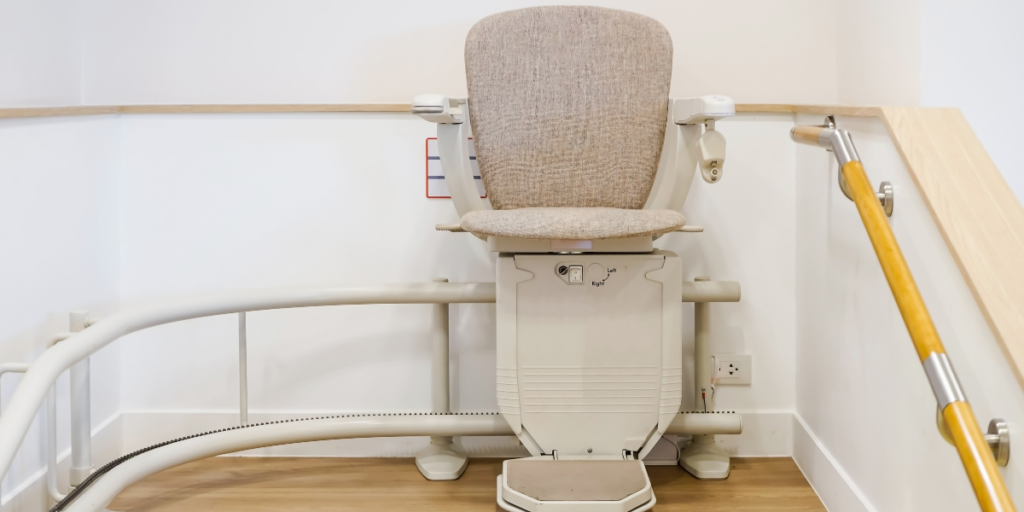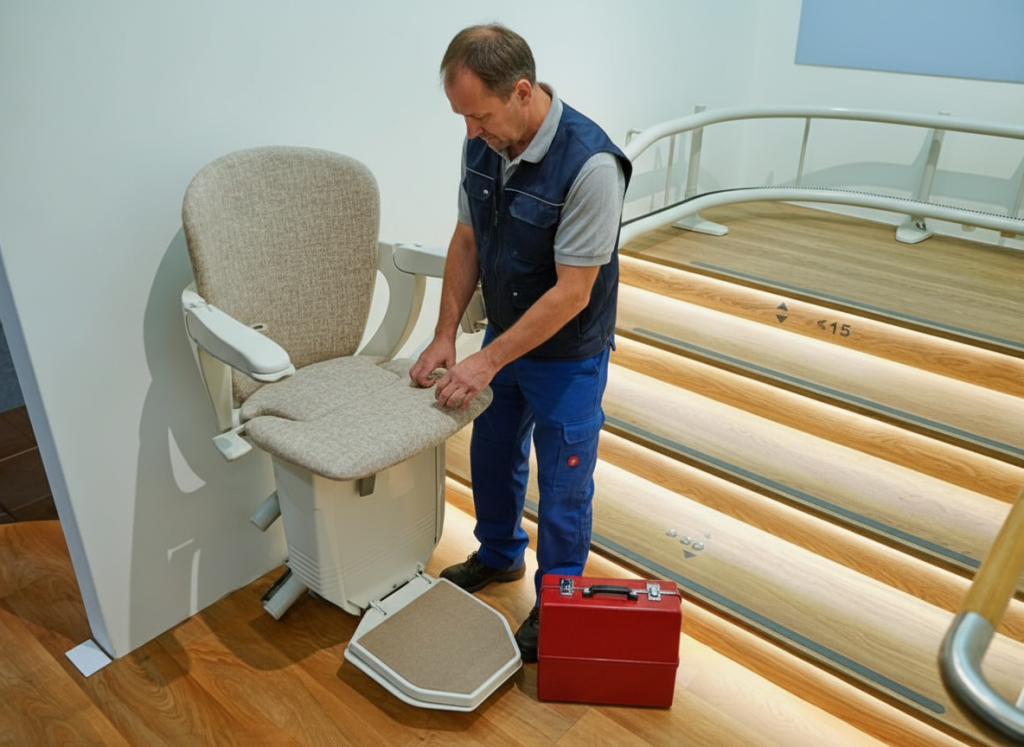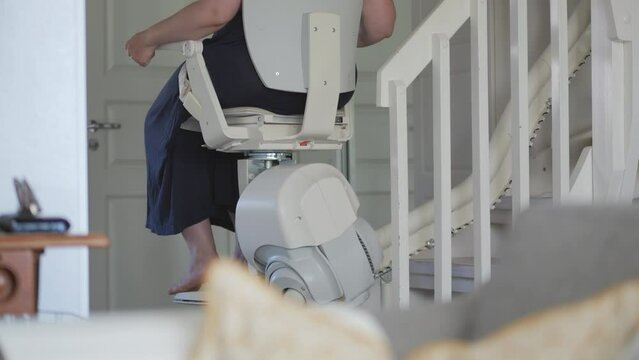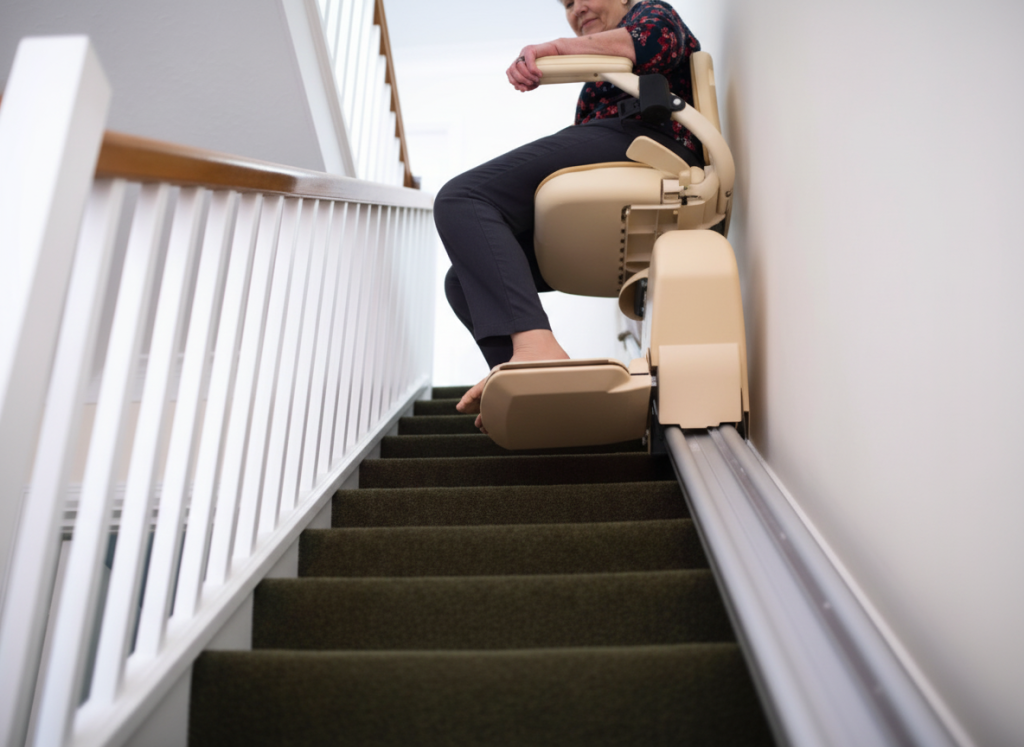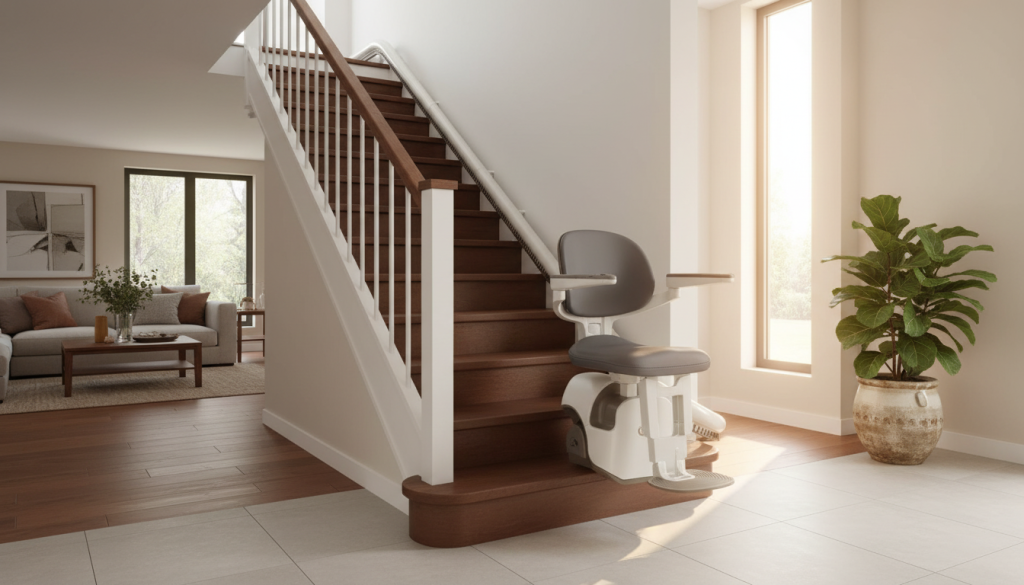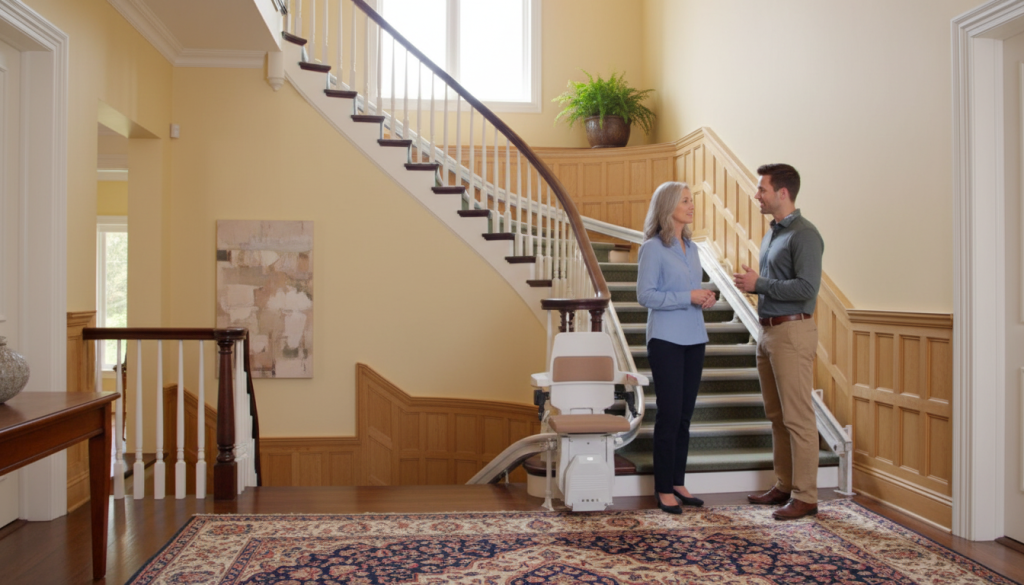When you’re considering a stairlift for your home, safety comes first. Modern stairlifts aren’t just mobility aids; they’re sophisticated pieces of engineering designed with multiple layers of protection. You’ll discover that today’s stairlifts come packed with intelligent safety features that work together, giving you peace of mind every time you use the stairs.
What are the most important safety features on stairlifts?
The foundation of stairlift safety lies in several key features that work seamlessly together. Seat belts keep you securely positioned throughout your journey, because staying safe means staying in place. Obstruction sensors act like invisible guardians, instantly stopping the stairlift if anything blocks the path ahead.
Battery backup systems mean your stairlift won’t leave you stranded during power cuts. These rechargeable batteries automatically take over, ensuring you can always reach your destination safely. Emergency stop buttons give you instant control, letting you halt the stairlift immediately if needed.
Swivel locks prevent the seat from rotating unexpectedly during travel. This means you stay facing forward and secure until you’re ready to get off at your destination. Safety sensors on the footrest detect pressure, so the stairlift won’t move if there’s an obstruction below.
How do modern stairlifts prevent falls and accidents?
Today’s stairlifts go beyond basic safety with intelligent monitoring systems. Smooth start and stop technology prevents sudden jolts that could throw you off balance. The gentle acceleration and deceleration feel natural, like a well-designed lift.
Anti-slip footrests provide a secure footing, even when your shoes are wet. Armrests lock in place during operation, giving you stable handholds throughout the journey. The rail system itself attaches securely to your stairs, not the wall, creating a rock-solid foundation.
Weight sensors monitor the load and won’t operate if the weight limit is exceeded. This protects both you and the stairlift mechanism. Speed controls keep the stairlift moving at a safe, comfortable pace that won’t cause dizziness or discomfort.
Straight stairlifts include sophisticated braking systems that engage automatically if any malfunction occurs. The stairlift will stop safely and securely, never leaving you in danger.
What happens if the power goes out during use?
Power cuts don’t spell disaster for modern stairlift users. Built-in battery backup systems take over instantly, often without you even noticing the switch. These batteries charge continuously while the stairlift sits idle, so they’re always ready when needed.
Most stairlift batteries can handle multiple trips, even during extended power outages. You’ll get enough power to complete your current journey and several more if necessary. The battery charge level displays clearly on the control panel, so you always know how much power remains.
Low battery warnings alert you well before the power runs out. The stairlift will beep or display a warning light when it’s time to park at a charging point. Emergency manual override systems let engineers move the stairlift by hand if the battery completely fails, though this rarely happens.
Some advanced models even have dual battery systems for extra security. If one battery fails, the second takes over automatically. This redundancy means you’re never left without a way to get where you need to go.
Are stairlifts safe for people with mobility conditions?
Stairlifts are specifically designed with mobility challenges in mind. Contrary to common misconceptions, stairlift myths debunked show that these devices are remarkably safe for people with various conditions.
Easy-to-use controls work perfectly for people with arthritis or limited dexterity. The toggle switches require minimal pressure and are positioned for comfortable reach. Remote controls let family members call the stairlift or move it out of the way when not needed.
Adjustable seat heights accommodate different users comfortably. Footrests adjust to match your leg length, ensuring proper support throughout the journey. Padded seats and backrests provide comfort during longer rides up multiple flights.
For people who struggle with sitting, perch seats offer a semi-standing position. These specialised seats provide support while allowing you to remain more upright. Safety harnesses keep you secure in this position, adapting to your specific mobility needs.
Curved stairlifts navigate turns and landings smoothly, with automatic speed adjustments around bends. The seat can swivel automatically on some models, positioning you safely for getting on and off at different angles.
How do safety sensors work on stairlifts?
Safety sensors form an invisible protection network around your stairlift. Multiple sensor types work together, creating overlapping safety zones that catch potential problems before they become dangerous.
Obstruction sensors use infrared beams to detect objects in the stairlift’s path. When something breaks these beams, the stairlift stops instantly. The sensors are sensitive enough to detect a pet, dropped item, or even a foot that’s not properly positioned.
Pressure sensors in the footrest and seat monitor your position throughout the journey. If you lift your feet or shift your weight unexpectedly, these sensors will pause the stairlift until you’re properly positioned again. This prevents accidents from sudden movements or improper positioning.
Rail sensors detect any problems with the track itself. If the rail becomes damaged or unstable, these sensors prevent the stairlift from operating until repairs are made. Track monitoring extends along the entire rail length, checking for obstructions, damage, or wear.
Some advanced models include tilt sensors that monitor the stairlift’s angle and stability. If the system detects unusual movement or tilting, it activates emergency braking systems immediately.
What safety features help during emergencies?
Emergency planning goes into every aspect of modern stairlift design. Emergency stop buttons are positioned within easy reach and stop all movement instantly when pressed. These bright red buttons are large enough to hit easily, even in panic situations.
Emergency lowering systems let the stairlift descend slowly to the nearest safe position if major problems occur. This prevents you from being stranded between floors during serious malfunctions. Manual release mechanisms allow trained service engineers to move the stairlift by hand during emergencies.
Backup communication systems in some models connect directly to emergency services or family members. A simple button press can alert others that you need help, even if your mobile phone isn’t nearby.
Emergency lighting activates during power cuts, illuminating the stairlift controls and the surrounding area. You’ll never be left in complete darkness, making it easier to operate the stairlift safely or call for help if needed.
Key lockout systems prevent unauthorised use during emergencies or maintenance. Family members can disable the stairlift if necessary, ensuring it won’t be used when unsafe conditions exist.
How do professionals ensure stairlift safety during installation?
Professional installation forms the cornerstone of stairlift safety. Qualified engineers assess your staircase thoroughly, checking for structural integrity and measuring precise angles. Every installation follows strict safety standards that have been developed over decades of experience.
Rail mounting uses heavy-duty brackets that attach directly to your stairs, creating an incredibly strong foundation. Engineers check weight-bearing capacity and structural soundness before beginning any installation work. Load testing ensures the complete system can handle well beyond normal operating weights.
Electrical connections meet strict safety codes, with proper earthing and circuit protection. Professional installers check your home’s electrical system to ensure compatibility and safety. All wiring is protected and hidden, preventing damage and maintaining a clean appearance.
For those considering specialist solutions, everything you need to know about standing stairlifts explains how these compact designs maintain the same rigorous safety standards while fitting into tight spaces.
Safety testing happens before you ever use your new stairlift. Engineers run multiple test cycles, checking every safety feature and sensor. They’ll teach you proper operation techniques and emergency procedures, ensuring you feel confident and secure.
Follow-up inspections catch any settling or adjustment needs after initial installation. Regular maintenance visits keep all safety systems working at peak performance, giving you continuous protection and peace of mind.
What maintenance keeps stairlifts operating safely?
Regular maintenance keeps your stairlift’s safety features working perfectly year after year. Professional service visits check every component, from mechanical parts to electronic sensors. This preventive approach catches small issues before they become safety concerns.
Battery health checks ensure your backup power system remains reliable. Engineers test battery capacity and charging systems, replacing batteries before they can fail unexpectedly. Cleaning battery terminals and connections prevents power interruptions.
Sensor calibration maintains the precise operation of safety systems. Over time, sensors can drift slightly out of adjustment, but regular calibration keeps them responding correctly to potential hazards. Rail cleaning removes dust and debris that could interfere with smooth operation.
Moving parts receive proper lubrication and adjustment. Worn components are replaced before they can compromise safety or reliability. Belt tensions, brake adjustments, and motor checks all contribute to continued safe operation.
Safety system testing during each maintenance visit verifies that emergency stops, obstruction sensors, and backup systems work correctly. You’ll receive a service record showing exactly what was checked and any work completed.
Why choose professional stairlift installation and service?
Professional expertise makes all the difference in stairlift safety. Qualified engineers understand the complexities of different staircase types and can spot potential issues that untrained installers might miss. They have the tools and knowledge to install your stairlift correctly the first time.
Certified training ensures engineers stay current with the latest safety standards and installation techniques. They understand building codes, electrical requirements, and mechanical specifications that guarantee safe operation. Professional installation comes with warranties and guarantees that protect your investment.
24/7 emergency support means help is always available when you need it. Whether it’s a simple operational question or an urgent repair need, professional service teams respond quickly. This ongoing support relationship keeps your stairlift safe and reliable throughout its lifespan.
Quality assurance programmes monitor installation and service standards. Professional companies track customer satisfaction and safety records, continuously improving their methods and training. This systematic approach to quality delivers consistently excellent results.
Modern stairlifts represent decades of safety innovation, combining multiple protection systems with user-friendly operation. When professionally installed and maintained, these sophisticated devices provide years of safe, reliable service. The comprehensive safety features built into today’s stairlifts give you the confidence to regain your independence and enjoy full access to your home.
Ready to discover how a professionally installed stairlift can enhance your home’s safety and accessibility? Contact OBAM’s experienced team for a free consultation and learn which safety features matter most for your specific needs.

